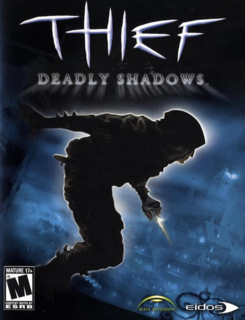The new and the old: T:DS blends old characteristics with new ideas almost perfectly.
Instead, if you have played the previous old-school Thief games, then prepare for something that looks different yet feels classic.
Let's examine each characteristic one by one.
Gameplay - As the title suggests, you're a thief. A pretty damn good one at that. The game is divided into missions, and have an adjustable difficulty setting which not only affects guards' behaviour and numbers, but even adds or removes objectives and elements to the mission itself. That grants replayability, as if you played the game on "Normal" and decide to replay it on "Hard" or "Expert", you'll discover many new things that never appeared in the lower difficulties. This is a characteristic of the whole series, and it hasn't been touched. The main difference from the old games is that you're in a semi-open world between each mission, so you have the time to roam about and do some lone thieving or shopping before going back to the serious business. It's still a pretty much linear game without much to do outside the main plot, so I'll be blunt: the whole "open world" thing was a letdown. But the main aspect of the game are obviously missions. Usually, they are made one -or more- unique objectives *and* a "loot" objective, which asks you to "borrow" a certain percentage of loot in the area (The percentage is controlled by the difficulty setting) before being allowed to leave, and a number of valuable treasures, usually well hidden and unique in the whole game (there are about three of them per mission).
You are well equipped: A dagger for close fights or ambushes, a blackjack to knock out enemies when they don't expect it, and several types of arrows used for different purposes, ranging from the ordinary to the "water" arrows, used to take out lit torches from a distance, and many more. Also, the protagonist will find several non-weapon items that can be true lifesavers, such as flash bombs, healing potions, and similar.
Enemies will react actively to any sound you make, and the player must be careful to where he's stepping on: a soft patch of grass or a carpet doesn't make the same noise as a metal floor. There are many ways to reduce the noise you make on these particular floors but usually the best way is to avoid them altogether when possible. The light factor is very important, and a little gem in the HUD tells you how well you're hidden. Its color ranges from pitch black to bright yellow, depending on your position and the surroundings. If the enemy sees or hears something odd, he will start searching for you actively and in the direction he heard the noise from or saw something moving. They aren't perfect though, and sometimes, not sure of what they heard or seen, they decide to just look around them or to ignore it altogether. In case you're found, you'd better be running: the protagonist is not a great face-to-face fighter. The AI is moderately smart when it comes to chasing you down, but after a time the poor guards will be too tired and just stop there panting for a while, giving you the opportunity to hide somewhere safe.
Graphics - Technically speaking, for its time, the models could have been a tad better. The ragdoll effects also look odd most of the time, but that just adds to the subtle vein of irony that flows through the entire series (I will explain the irony factor later). Lights, needless to say, are well placed and the most important part of the gameplay, and they contribute to creating a very immersive medieval atmosphere with some steampunk elements, yet not as many as the series used to. All the other world elements are very well designed, even in detail, and it strikes me as odd that they didn't put the same effort into models. Satisfying graphics, nonetheless.
Sound - One of the Thief series' strong points is its sounds, which are not only an important part of the gameplay, but also exceptionally realistically made. That includes the voice acting, which blends perfectly with the overall atmosphere of the game. Obviously, this game gains a lot if played with headphones on.
Atmosphere - Immersive and very, very unique. Thief's imaginary world is a blend of medieval cities and steampunk machines, magical artifacts and strictly realistic elements. There's no word that can define it properly, if not "Thief". Smiles are assured while playing this game: in fact, the game likes to play a lot on subtle irony. Funny lines from the guards, cold one-liners from the protagonist, and even people's normal conversations. In fact, most of the world is wrapped in a slight veil of irony that makes everything look totally different from what an ordinary city should be. Almost surreal.
Overall - So much said, and so much to be said about this game. But you'd better discover all the other elements by yourself. Probably the worst game in the series, but also the most innovative. And being the worst doesn't necessarily mean being bad: in fact, this game is amazing if compared to other products in the market. The problem is that some of the characteristics that have been added to the series have been a total letdown, so the game feels slightly flawed. Talking about flaws, bugs are very limited, and it works flawlessly on many machines, mine included. Almost bug-free, I'd say.
You should definitely give it a try, it's worth more than its price. Even if you're not into the genre, Thief deserves at least half a playthrough.

